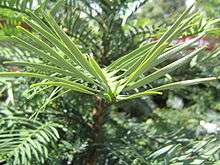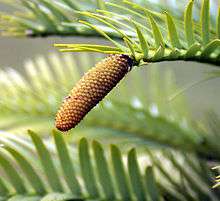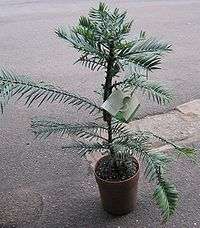Wollemia
| Wollemia Temporal range: Jurassic to recent 200–0 Ma | |
|---|---|
 | |
| Young specimen in a botanical garden protected from theft by a steel cage | |
| Scientific classification | |
| Kingdom: | Plantae |
| Division: | Pinophyta |
| Class: | Pinopsida |
| Order: | Pinales |
| Family: | Araucariaceae |
| Genus: | Wollemia |
| Species: | W. nobilis |
| Binomial name | |
| Wollemia nobilis W.G.Jones, K.D.Hill & J.M.Allen | |
Wollemia is a genus of coniferous tree in the family Araucariaceae. Wollemia was only known through fossil records until the Australian species Wollemia nobilis was discovered in 1994 in a temperate rainforest wilderness area of the Wollemi National Park in New South Wales, in a remote series of narrow, steep-sided sandstone gorge 150 km north-west of Sydney. The genus is named for the National Park.[2]
In both botanical and popular literature the tree has been almost universally referred to as the Wollemi pine, although it is not a true pine (genus Pinus) nor a member of the pine family (Pinaceae), but rather is related to Agathis and Araucaria in the family Araucariaceae. The oldest fossil of the Wollemi tree has been dated to 200 million years ago.[3]
The Wollemi pine is classified as Critically Endangered (CR) on the IUCN's Red List,[1] and is legally protected in Australia.[4] A Recovery Plan has been drawn up, outlining strategies for the management of this fragile population; the overall objective is to ensure that this species remains viable in the long-term.[4]
Description
Wollemia nobilis is an evergreen tree reaching 25–40 m (82–131 ft) tall. The bark is very distinctive, dark brown and knobbly, quoted as resembling Coco Pops breakfast cereal.[5] The tree coppices readily, and most specimens are multiple-trunked or appear as clumps of trunks thought to derive from old coppice growth, with some consisting of up to 100 stems of differing sizes.[4] The branching is unique in that nearly all the side branches never have further branching. After a few years, each branch either terminates in a cone (either male or female) or ceases growth. After this, or when the cone becomes mature, the branch dies. New branches then arise from dormant buds on the main trunk. Rarely, a side branch will turn erect and develop into a secondary trunk, which then bears a new set of side branches.

The leaves are flat linear, 3–8 cm long and 2–5 mm broad. They are arranged spirally on the shoot but twisted at the base to appear in two or four flattened ranks. As the leaves mature, they develop from bright lime-green to a more yellowish-green.[6] The seed cones are green, 6–12 cm long and 5–10 cm in diameter, and mature about 18–20 months after wind pollination. They disintegrate at maturity to release the seeds which are small and brown, thin and papery with a wing around the edge to aid wind-dispersal.[4] The male (pollen) cones are slender conic, 5–11 cm long and 1–2 cm broad and reddish-brown in colour and are lower on the tree than the seed cones.[4] Seedlings appear to be slow-growing[4] and mature trees are extremely long-lived; some of the older individuals today are estimated to be between 500 and 1000 years old.[6]
Discovery

The discovery, on or about 10 September 1994, by David Noble, a field officer of the Wollemi National Park in Blackheath, in the Blue Mountains, only occurred because of his adventurous bushwalking and rock climbing abilities. Noble had good botanical knowledge, and quickly recognised the trees as unusual and worthy of further investigation. Returning with specimens, and expecting someone to be able to identify the plants, Noble soon found that they were new to science.[7] The species was subsequently named after him.[8] Further study would be needed to establish its relationship to other conifers. The initial suspicion was that it had certain characteristics of the 200-million-year-old family Araucariaceae, but was not similar to any living species in the family. Comparison with living and fossilised Araucariaceae proved that it was a member of that family, and it has been placed into a new genus with Agathis and Araucaria. Fossils resembling Wollemia that are possibly related to it are widespread in Australia, New Zealand and Antarctica, but Wollemia nobilis is the sole living member of its genus. The last known fossils of the genus date from approximately 2 million years ago.[9] It is thus described as a living fossil, or alternatively, a Lazarus taxon.
Fewer than a hundred trees are known to be growing wild, in three localities not far apart. It is very difficult to count them as most trees are multistemmed and may have a connected root system. Genetic testing has revealed that all the specimens are genetically indistinguishable, suggesting that the species has been through a genetic bottleneck in which its population became so low (possibly just one or two individuals) that all genetic variability was lost.[10]
In November 2005, wild-growing trees were found to be infected with Phytophthora cinnamomi.[11] New South Wales park rangers believe the virulent water mould was introduced by unauthorised visitors to the site, whose location is still undisclosed to the public.[11]
Cultivation and uses

A propagation programme made Wollemi pine specimens available to botanical gardens, first in Australia in 2006 and subsequently throughout the world. It may prove to be a valuable tree for ornament, either planted in open ground or for tubs and planters. In Australia, potted native Wollemi pines have been promoted as a Christmas tree.[12] It is also proving to be more adaptable and cold-hardy than its restricted temperate-subtropical, humid distribution would suggest, tolerating temperatures between −5 and 45 °C (23 and 113 °F), with reports, from Japan and the USA, that it can survive down to −12 °C (10 °F). A grove of Wollemi pines planted in Inverewe Garden, Scotland, believed to be the most northerly location of any successful planting, have survived temperatures of −7 °C (19 °F), recorded in January 2010.[13] It also handles both full sun and full shade. Like many other Australian trees, Wollemia is susceptible to the pathogenic water mould Phytophthora cinnamomi, so this may limit its potential as a timber tree.[14]
Phylogeny
The genus Wollemia shares morphological characteristics with the genera Araucaria and Agathis. Wollemia and Araucaria both have closely crowned sessile and amphistomatic leaves, and aristate bract scales, while Wollemia and Agathis both have fully fused bracts, ovuliferous scales, and winged seeds.[15] Scrutiny of the fossil record likewise does not clarify Wollemia’s relationship to Araucaria or Agathis, since the former has similarly disparate leaf characters in its adult and juvenile forms, and the latter has similar cone characters.[16] Further, the recent description of several extinct genera within the Araucariaceae points to complex relationships within the family and a significant loss of diversity since the Cretaceous.[17][18] An early study of the rbcL gene sequence places Wollemia in the basal position of the Araucariaceae and as the sister group to Agathis and Araucaria.[19] In contrast, another study of the rbcL sequence shows that Wollemia is the sister group to Agathis and Araucaria is basal.[20] The different outgroup selection and genes used in previous studies are the reasons behind the discrepancy over the groupings of the three genera.[21] Later genetic studies corroborate Wollemia’s placement in the Araucariaceae as sister to Agathis based on data from the 28s rRNA gene,[22] a combination of rbcL and matK genes,[23] and a comprehensive study encompassing nuclear ribosomal 18S and 26S rRNA, chloroplast 16S rRNA, rbcL, matK and rps4, and mitochondrial coxl and atp1 genes.[21]
Fossils indicate that the lineage leading to modern Agathis and Wollemia evolved from the common ancestor with Araucaria in the Early Cretaceous in southern Gondwana[24] within climates experiencing cool moist conditions and a strong photoperiod regime.[25] The most recent common ancestor of Agathis and Wollemia has been proposed to be at least 110 million years old (Early Cretaceous) deduced from the reported oldest fossils of these genera.[24] However, genetic evidence suggests that the divergence of Agathis and Wollemia occurred 61±15 Ma around the beginning of the Cenozoic rather than in the Early Cretaceous.[21] In another recent molecular study, an age of only 18 Ma was inferred for the divergence of Agathis and Wollemia.[26] This also accords with recent revisions of the fossil record in New Zealand that reveal no examples of Agathis or Wollemia-like remains older than the Cenozoic.[27] The relatively minor genetic and morphological diversity in extant species of Agathis compared to the variation in Araucaria is further evidence of the earlier divergence of Araucaria.[28]
Below is the phylogeny of the Araucariaceae based on the consensus from the most recent cladistic analysis of molecular data. It shows the relative positions of Wollemia, Agathis, and Araucaria within the division.
| |
| ||||||
| | |||||||
| |
| ||||||
| |
References
This article incorporates text from the ARKive fact-file "Wollemia" under the Creative Commons Attribution-ShareAlike 3.0 Unported License and the GFDL.
- 1 2 Thomas, P. (2011). "Wollemia nobilis". IUCN Red List of Threatened Species. Version 2014.3. International Union for Conservation of Nature. Retrieved 13 May 2014.
- ↑ https://www.rbgsyd.nsw.gov.au/annan/the_garden/Plant_of_the_Month/wollemia_nobilis
- ↑ Fact Sheet: Wollemi Pine
- 1 2 3 4 5 6 NSW National Parks and Wildlife Service (1998) Wollemi Pine (Wollemia nobilis) Recovery Plan. NPWS, Sydney. Available at http://www.nationalparks.nsw.gov.au/npws.nsf/Content/Home
- ↑ James Woodford, The Wollemi Pine: The incredible discovery of a living fossil from the age of the dinosaurs, (Revised Edition), The Text Publishing Company, 2002, ISBN 1-876485-74-4
- 1 2 "wollemi pine/facts & figures". Royal Botanic Gardens, Sydney. April 2003. - via ARKive
- ↑ "The Wollemi Pine — a very rare discovery". Royal Botanic Gardens, Sydney. Archived from the original on 2005-03-23. Retrieved 2007-02-08.
- ↑ Thornhill, Andrew. "Growing Native Plants: Wollemia nobilis". Australian National Botanic Gardens.
- ↑ "Wollemi Pine research — Age & Ancestry". Royal Botanic Gardens, Sydney. Archived from the original on 2005-03-23. Retrieved 2007-03-01.
- ↑ Peakall, Rob; Ebert, Daniel; Scott, Leon J.; Meagher, Patricia F.; Offord, Cathy A. (2003). "Comparative genetic study confirms exceptionally low genetic variation in the ancient and endangered relictual conifer, Wollemia nobilis (Araucariaceae)". Molecular Ecology 12 (9): 2331–2343. doi:10.1046/j.1365-294X.2003.01926.x.
- 1 2 Salleh, Anna (4 November 2005). "Wollemi pine infected by fungus". ABC.
- ↑ ACF - Tips for treading lightly this festive season. Australian Conservation Foundation. 2010-12-01. Retrieved 2010-12-19.
- ↑ "Jurassic tree survives big chill in trust garden". BBC. 2010-11-01. Retrieved 2010-01-13.
- ↑ "Wollemi Pine research — fungal associations & pathogens". Royal Botanic Gardens, Sydney. Archived from the original on 2005-05-01. Retrieved 2007-02-08.
- ↑ Jones, W.G.; Hill, K.D.; Allen, J.M. (1995). "Wollemia nobilis, a new living Australian genus and species in the Araucariaceae". Telopea 6 (2-3): 173–6.
- ↑ Chambers, T. Carrick; Drinnan, Andrew N.; McLoughlin, Stephen (January 1998). "Some Morphological Features of Wollemi Pine (Wollemia nobilis: Araucariaceae) and Their Comparison to Cretaceous Plant Fossils". International Journal of Plant Sciences 159 (1): 160–71. doi:10.1086/297534. JSTOR 2474948.
- ↑ Cantrill, David J.; Raine, J. Ian (November 2006). "Wairarapaia mildenhallii gen. et sp. nov., a New Araucarian Cone Related to Wollemia from the Cretaceous (Albian‐Cenomanian) of New Zealand". International Journal of Plant Sciences 167 (6): 1259–69. doi:10.1086/507608.
- ↑ Dettmann, Mary E.; Clifford, H. Trevor; Peters, Mark (2012). "Emwadea microcarpa gen. Et sp. Nov.—anatomically preserved araucarian seed cones from the Winton Formation (late Albian), western Queensland, Australia". Alcheringa 36 (2): 217–37. doi:10.1080/03115518.2012.622155.
- ↑ Setoguchi, Hiroaki; Osawa, Takeshi Asakawa; Pintaud, Jean-Christophe; Jaffré, Tanguy; Veillon, Jean-Marie (November 1998). "Phylogenetic relationships within Araucariaceae based on rbcL gene sequences". American Journal of Botany 85 (11): 1507–16. doi:10.2307/2446478. PMID 21680310.
- ↑ Gilmore, S.; Hill, K. D. (1997). "Relationships of the Wollemi Pine (Wollemia nobilis) and a molecular phylogeny of the Araucariaceae" (PDF). Telopea 7: 275–91.
- 1 2 3 Liu, Nian; Zhu, Yong; Wei, Zongxian; Chen, Jie; Wang, Qingbiao; Jian, Shuguang; Zhou, Dangwei; Shi, Jing; Yang, Yong; Zhong, Yang (2009). "Phylogenetic relationships and divergence times of the family Araucariaceae based on the DNA sequences of eight genes". Chinese Science Bulletin 54 (15): 2648–55. doi:10.1007/s11434-009-0373-2.
- ↑ Stefanović, Saša; Jager, Muriel; Deutsch, Jean; Broutin, Jean; Masselot, Monique (May 1998). "Phylogenetic relationships of conifers inferred from partial 28S rRNA gene sequences". American Journal of Botany 85 (5): 688. doi:10.2307/2446539. PMID 21684951.
- ↑ Quinn, C. J.; Price, R. A.; Gadek, P. A. (2002). "Familial Concepts and Relationships in the Conifer Based on rbcL and matK Sequence Comparisons". Kew Bulletin 57 (3): 513–31. doi:10.2307/4110984. JSTOR 4110984.
- 1 2 Kunzmann, Lutz (2007). "Araucariaceae (Pinopsida): Aspects in palaeobiogeography and palaeobiodiversity in the Mesozoic". Zoologischer Anzeiger 246 (4): 257–77. doi:10.1016/j.jcz.2007.08.001.
- ↑ McLoughlin, Stephen; Vajda, Vivi (2005). "Ancient Wollemi Pines Resurgent". American Scientist 93 (6): 540–7. doi:10.1511/2005.6.540.
- ↑ Crisp; Cook (2011). "Cenozoic extinctions account for the low diversity of extant gymnosperms compared with angiosperms". New Phytologist 192: 997–1009. doi:10.1111/j.1469-8137.2011.03862.x.
- ↑ Pole, Mike (2008). "The record of Araucariaceae macrofossils in New Zealand". Alcheringa 32 (4): 405–26. doi:10.1080/03115510802417935.
- ↑ Kershaw, Peter; Wagstaff, Barbara (2001). "The Souther Conifer Family Araucariaceae: History, Status, and Value for Paleoenvironmental Reconstruction". Annual Review of Ecology and Systematics 32: 397–414. doi:10.1146/annurev.ecolsys.32.081501.114059.
External links
- Wollemia nobilis media at ARKive
- Conifer Specialist Group (1998). Wollemia nobilis. 2006. IUCN Red List of Threatened Species. IUCN 2006. www.iucnredlist.org. Retrieved on 11 May 2006. Listed as Critically Endangered (CR D v2.3)
- "The Wollemi Pine — a very rare discovery". Royal Botanic Gardens, Sydney. Archived from the original on 2005-03-23. Retrieved 2007-02-08. (includes facts and figures, ecology, biology)
- Royal Botanic Gardens at Kew's web page about the "Wollemi Pine"
- WollemiPine.com
- Wollemia nobilis at the Gymnosperm Database
- BBC News item 10 May 2005
- BBC News - 'Dinosaur trees' heavily guarded - 02/12/06
- ABC-TV Gardening Fact Sheet
- ABC-TV Science visits Wollemi Pines in the wild 19 May 2005
- Wollemia nobilis (Wollemi Pine) Recovery Plan, January 2007
- Warren, Matthew (16 April 2007). "Biologist takes axe to the 'myth' of Wollemi". The Australian. Retrieved March 4, 2014.
- The Wollemi Pine Transcript of interview on The Science Show (April 2007) with Tim Entwisle, then director of the Royal Botanic Gardens in Sydney.
- Images and information about the Wollemi Pine in Westonbirt Arboretum
- Wollemi Pine available for first time in North America from National Geographic.
